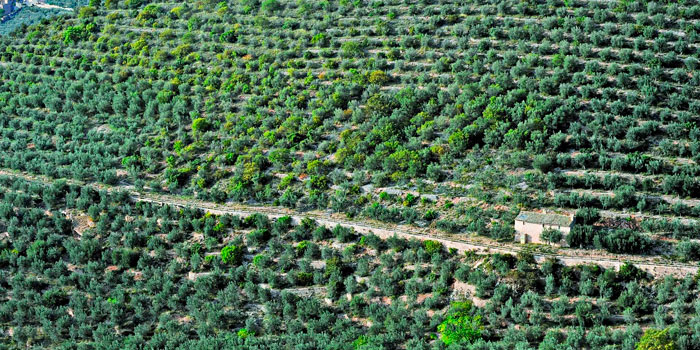Olive Groves of the Slopes between Assisi and Spoleto, Italy
GIAHS since 2018

Global importance
Historically, the area proposed is one of the most important areas in Italy for olive growing. Olive pits were found in Etruscan graves dating back to the 7th century BC, while archaeological sites of Roman olive mills of the 1st century AD can be found in the area.
Nowadays, Olive oil produced in the area is certified DOP certifying a high quality of the product and ensuring a specific way of cultivation and making process. Indeed, the Olive Slopes between Assisi and Spoleto are characteristics based terraces cultivation that have been constructed based on traditional knowledge and maintained until now.
Food and livelihood security
Today the surface destined to olive cultivation in Umbria is about 27,000 ha, with an olive production that varies, depending on the year, between 30,000 and 60,000 tons, with an average yield of about 18.5% and a final production of oil between 5,500 and 11,000 tons. The number of olive plants cultivated in Umbria is about 5.5 million.
Oil production in Umbria is quite relevant economically, being in fact 5% of the gross marketable agricultural production, and involves about 27,000 farms and 270 oil mills.
The production of “Umbria” extra virgin olive oil receives an EU certification of Protected Designation of Origin. The aim of the DOP is to assure the consumer, ensure a greater profit for the farmer, promote and certify the quality of the oil through the strict observance of the production regulation, and organize the sales chain.
Agrobiodiversity
The olive tree is one of the oldest cultivated fruit trees and originated from the Mediterranean region. The proposed site grow three main varieties: Moraiolo is one of the most renowned and exquisite olive cultivars, providing one of the best Italian oils. The Frantoio cultivar is widespread in central Italy. The Leccino cultivar is spread throughout Italy and other parts of the world, although its origin is to be found in Tuscany.
Aside Olive trees, many local varieties were identified regionally as far as species of agricultural interest are concerned, especially cultivars of fruit trees and herbaceous cultivation. Aside from olive trees and grape vines, in the proposed area there are other crops of agro-industrial interest, i.e. local cultivars important for the enhancement of agro-biodiversity.
The existence of a significant number of diverse plants of the Mediterranean flora in cultivated olive groves establishes the conditions for the creation of a multitude of habitats for animals.
Local and traditional knowledge systems
Several olive trees cultivation actions are based on traditional knowledge notably:
-Planting,
- Pruning: Traditionally, the olive groves present on the Assisi-Spoleto slopes are grown in an open centre bush shape to obtain bushy crown and
- Harvesting tasks made by hand with nets spread under the plants to collect the fruits dislodged by “grazing”, which is carried out with a specific handbrake, which is used to comb the branches to remove olives with as few leaves as possible without damaging the structure of the tree.
In addition, the multifunctional role of terraces is one of the main pillow of the system: three types of terraces exist in the same system dry stone terraces, earth terraces and dry stone lunette. Terraces play an important role for the ecosystem of soils and landscape management.
Culture, value systems and social organizations
The olive tree occupies a predominant place in the Mediterranean world because it has always been typical of its agricultural landscape, its eating habits, and its cultural and religious symbolism. Since ancient times, the olive tree was considered a transcendent symbol of spirituality and holiness. The olive tree became part of local culture also thanks to its identification as a symbol of peace used by Saint Francis of Assisi (10th century AD), to the point that it has nearly become the heraldic emblem of Umbria.
Landscapes features
The landscape of the proposed area is characterized by a series of stone terraces, developed on mountain slopes extending from Assisi to Spoleto between 200 and 600 m a.s.l., with a highly fragmented landscape mosaic that has preserved most of its integrity.
The constant remodelling of the slopes through the realization of extensive hydraulic systems not only allows to cultivate slopes that would be otherwise too steep, but constitutes a defence against hydrogeological risk and an efficient system for the preservation of water and soil.

